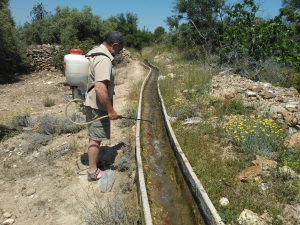The Barranc de la Conca rises from different sources in the Toscar area, and runs between the mountains of the Ports until it crosses the plains of Alfara and flows into the Ebro at the height of Aldover. In this journey we clearly differentiate two sectors: a first sector located in the upper part of the ravine, the one that runs between the mountains, which is more humid and in which we have found a great larval density; and a second sector, in the lower part of the ravine, that of the plain, drier and with little importance as habitats for simulid larvae. The first sector, that of the upper part of the ravine, and which is ultimately where the control tasks are centered, presents a series of short-distance channels on both sides of the ravine that serve to irrigate the different crops in the area. Black fly larvae also develop in all these water pipes.

Sampling: the sampling carried out in this area to detect black fly larvae is based on the observation of the macrophytes found in the riverbed, mainly of the genus Nasturtium (watercress), on which they fix on the leaves or Stems the larvae and pupae of the black fly.

Control: it is carried out manually by applying Bti with the help of a backpack where the product is mixed with the necessary water to obtain an adequate concentration of product and a volume of the mixture that allows us to apply the product for a certain time . The little circulating flow as well as the irregularity in the current, alternating areas with surface water with a certain current and areas without current or with underground circulation, mean that the amount of product applied in each case is determined by the application time, which in Points function can vary between 2 and 4 minutes




